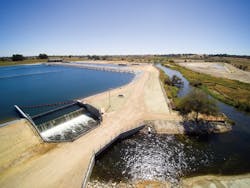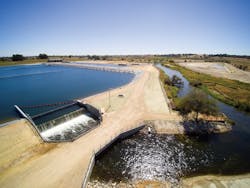Recognizing Excellence in Water Quality Treatment Approaches
WWTP expansion, phosphorus removal project named Public Works Projects of the Year
When the American Public Works Association (APWA) announced the winners of its 2018 Public Works Projects of the Year in late 2018, two water projects conceptualized and designed by Brown & Caldwell took home top honors: the Chambers Creek Regional Wastewater Treatment Plant Expansion (Pierce County, Wash., Planning and Public Works) and the Dixie Drain Phosphorus Removal Facility (City of Boise, Idaho, Public Works Department).
“These exemplary projects set a precedent for innovation in water quality treatment approaches,” Brown & Caldwell CEO Rich D’Amato said in a press release following the announcement.
Dixie Drain Phosphorus Removal Facility
The $21 million Dixie Drain Phosphorus Removal Facility is the first of its kind in the U.S., considered a model facility in watershed-based approaches to meeting total maximum daily load limits. Treating 130 million gallons of water daily (MGD), the facility collects groundwater and surface water from agricultural operations in the lower Boise River watershed, removing 140 pounds of phosphorus per day (10 tons annually). The facility yields significant environmental benefits as it collects 50 percent more phosphorus downstream from the Boise River. For every pound not removed at an upstream water renewal facility, 1.5 pounds are removed downstream. The result is a better quality of water flowing through the Boise and Snake rivers.
“The Lower Boise River is instrumental to the vibrancy and livability of Boise,” Tadd Giesbrecht, project manager and vice president of Brown & Caldwell, said. “With the Dixie Drain Phosphorus Removal Facility, Boise continues to demonstrate its commitment to enhancing the river to support multiple community uses throughout the Treasure Valley.”
The Dixie Drain Phosphorus Removal Facility is a model for using conventional treatment technologies in an innovative way, he added. “This ground-breaking approach maximized the location of the new facility, built 34 miles downstream of the city’s existing water renewal facility, to divert water from the Dixie Drain and use chemical precipitation to remove up to 140 pounds of phosphorus per day.” That’s 50 percent more than would have been removed at the city’s water renewal facilities alone, he noted, resulting in a solution that provides significantly greater environmental benefit to the Boise and Snake rivers.
The Dixie Drain Phosphorus Removal Facility treats 130 million gallons of water daily (MGD) and is considered a model facility in watershed-based approaches for meeting total maximum daily load limits. Image courtesy Chad Case.
Chambers Creek Regional Wastewater Treatment Plant Expansion
Supporting Pierce County’s future growth and economic development, the $342 million Chambers Creek Regional Wastewater Treatment Plant Expansion Project increased capacity at the plant from 28.7 MGD to 45 MGD.
“This project was the largest public works project ever undertaken by Pierce County,” said Jeff Morgan, Brown & Caldwell’s director of project management. “Each step forward in the design process reflected the input of ratepayers, elected officials, and county staff to ensure that value was being delivered. Working together, we were better able to incorporate the county’s preferences into the design to help them achieve their goals and keep the project under budget.”
The plant is an integral part of Chambers Creek Properties, which consists of 930 acres of public amenities, including a wetland and watershed reserve, a park with more than two miles of marine waterfront, sports fields, a wetland conservation area, walking trails, an outdoor entertainment venue and the Chambers Bay golf course.
Before being acquired by Pierce County, the site had been an operating sand and gravel mine for more than 100 years. Brown & Caldwell assisted with site acquisition and then led the planning and permitting to establish a permanent 180-acre utility reserve and buffer within the property to provide for multiple utility functions, including the expanded Chambers Creek Regional WWTP, Morgan said.
“The Chambers Creek Regional WWTP is one of the first wastewater treatment facilities in the U.S. to implement the Annamox DEMON® technology for the removal of nitrogen from plant sidestream flows, in this case centrate from the digested sludge dewatering operation,” he said. The technology improves the ammonia removal capability of the plant by 25 percent using a fraction of the tankage volume required for the main plant flow, he explained.
Using a naturally-occurring bacteria (anammox) to strip nitrogen from wastewater, the method reduces chemical use by 50 percent and oxygen (energy) demands by 25 percent. The upgrades will save the county $7 million in life-cycle costs, in addition to the $30 million saved by efficiently repurposing existing structures rather than constructing new facilities.
Further upgrades include increased biogas utilization capacity to generate heat for the treatment process and occupied spaces. The addition of a reclaimed water production and distribution system provides Class A reclaimed water for in-plant use, therefore reducing effluent discharges to Puget Sound.
Other technologies in use at the plant include a sludge dryer to produce the county’s Class A biosolids product, SoundGRO; ultraviolet disinfection of the final effluent; and a reclaimed water facility that produces Class A reclaimed water for reuse inside the plant, with the capacity to serve additional uses outside the plant in the future.
The upgraded plant will serve a population projected to double to 361,000 by 2040.
D’Amato said, “We applaud the City of Boise and Pierce County for their commitment to improving public health in a sustainable, environmentally-friendly way. Brown & Caldwell is proud to have played a role in enhancing the health of these communities now, and well into the future.” WW
About Brown & Caldwell: Headquartered in Walnut Creek, Calif., Brown & Caldwell is a full-service environmental engineering and construction firm with 45 offices and 1,600+ professionals across the country. For more information, visit www.brownandcaldwell.com.

